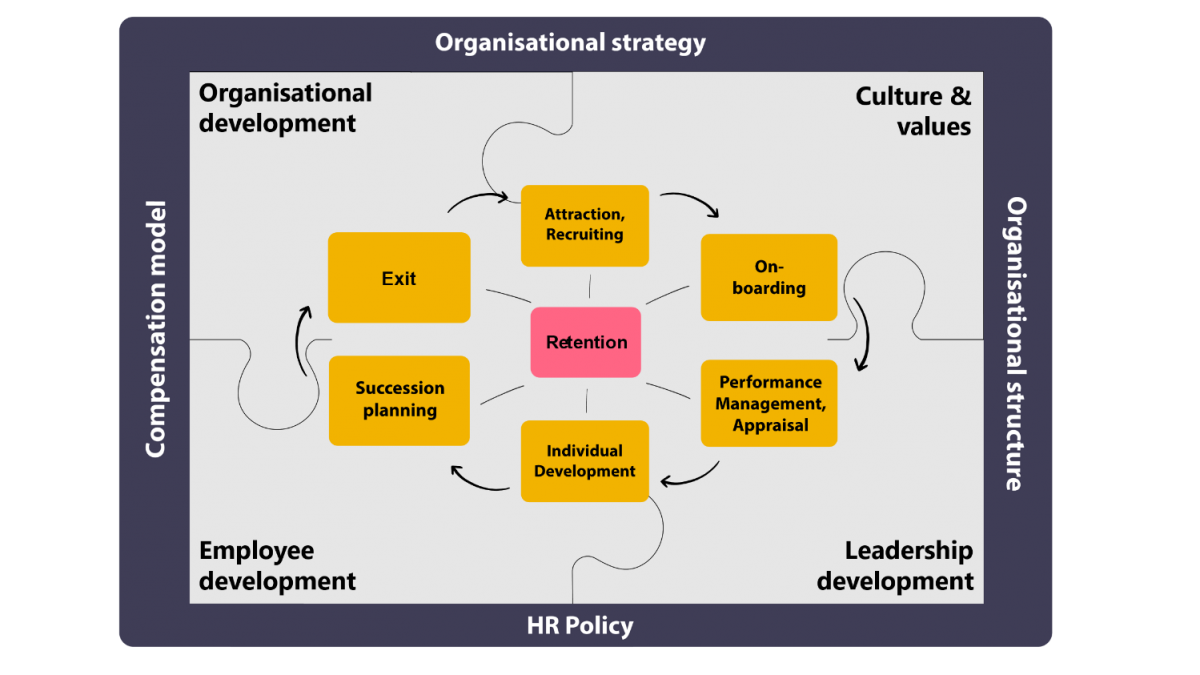In September 2021, the European Microfinance Platform (e-MFP) published the results of a survey that mapped Human Resource Development (HRD) Practices in the Microfinance Sector and highlighted opportunities for acting on those results. This was followed by a series of blogs presenting thematic case studies which explore the actions that some survey participants have taken to address each area and introduce practical tools that might guide practitioners in putting new HR practices into practice. This is the fifth and final blog in the series. Along with the previous blog that presents a framework to support managers in their HRD role, this blog outlines how MFIs can lift-up their HR function to a new level and thereby actively contribute to their organization’s success.
 Service sector organizations are people centred organizations
Service sector organizations are people centred organizations
How satisfied are you with the HR processes in your organization? Does your organization manage to bring to life the potential that lies within its employees?
From our experience in working with many MFIs around the globe on diagnosing and further developing their HR systems, we heard many MFIs complain about high numbers of turnover and their struggle to retain the talent they need to sustain and grow their business. Moreover, we experienced that HR is often reduced to an administrative function not sitting at the table when strategic business decisions are made.
Let us pause a moment on this observation and ask ourselves: who is implementing the organization’s strategy? Right, its people! Especially in financial institutions like MFIs, it is the employees who make the MFI’s mission and purpose tangible in their daily interactions – they interact with customers, answer their queries and concerns, develop new products and services, and get customers excited about them.
In fact, HRM structure and capacity were mentioned as the major hindering factor for human resource development in a recent survey carried out by the e-MFP HR Action Group. But what can be done to align HR practices with the organization’s strategy and create a work environment that allows for an atmosphere of trust and openness and makes people want to contribute to the organization’s success?
In addition to the insights from the first and the third (part 1 and part 2) blogs of this series, here we would like to introduce ADG’s strategic HR approach (ASHRA) as it can both provide a guideline in finding answers to those questions and also be a practical tool for the annual strategy review that is recommended as the fifth opportunity for action in the survey report on HRD practices in the microfinance sector.
ADG’s strategic HR approach (ASHRA)
ASHRA has evolved from the Talent Management Life Cycle (TMLC) that was used to structure the survey on HRD practices in the microfinance sector.
The TMLC describes the stages that an employee passes during her/his time working for the MFI. The stages, visualized as orange boxes in the graph below, follow the typical life cycle of an employee, starting from attraction and recruitment through onboarding, performance management and appraisal, development, succession planning, and exit from the organization.
Interestingly, all these stages are built around “retention”, i.e., whether the individual employee decides to stay with the MFI and/or the MFI actively tries to retain the employee. Thus, the experience of the individual employee at every stage finally influences the variable “retention”.
It is important to highlight that ‘talent’ in this regard does not refer to a few employees but to all employees in the organization. Everybody has talents that need to be identified and leveraged by assigning roles and tasks suitable to nurture these talents. In addition, an MFI can identify the so called “high potentials”, i.e., individuals with outstanding performance outcomes or leadership skills.
The stages of the TMLC can be read as administrative tasks that need to be executed by the HR department in a consecutive manner. However, this takes a rather isolated perspective. With ASHRA we would like to stimulate a different and multi-dimensional view of HR: HR is placed in the centre of any service sector organization as it directly affects organizational success, through e.g., satisfied customers. And vice-versa: the organization’s strategy and policies influence its HR approach. Thus, the design and the practices at every stage of the TMLC potentially have a direct effect on KPIs. For example, a newly contracted loan officer who has been rushed through an onboarding process that did not cater for her needs, most likely will feel unsecure with clients. This hampers the quality of customer service she can provide. If this translates into underperformance, that makes her feel uncomfortable with the job and it increases the chances that she is going to look for a new job opportunity.
ASHRA goes one step further: it broadens the view on HR, illustrates how HR can boost performance and what needs to be in place for HR to be able to fulfil this expectation. To this end, ASHRA puts forward that the design of and the practices related to the TMLC are influenced by and influence the following four dimensions:
- Culture and values
- Leadership development
- Employee development
- Organizational development
The MFI’s Culture and Values encompass the organization’s mission and purpose (i.e., its reason for existing) as well as customs and behaviours that are unique to the MFI. Moreover, the leadership style and the approach on cooperation that are characteristic for the organization are elements of the MFI’s culture and values. Also, the dominant communication style plays a role here, as well as the approach towards handling change and the resilience with respect to crisis. All these aspects are strongly linked to the TMLC as they determine how the individual stages of the TMLC are designed and implemented in practice. For example, in an organization that is characterized by open communication, a cooperative attitude and teamwork, the onboarding phase might look different from an organization that is characterized by competition and a focus on individual efforts. And vice versa is true as well: the type of talent that is attracted to and recruited for the MFI influences its culture and values – a fluent and ever-changing concept determined by the sum of attitudes, interactions and everyday behaviours that are practiced and experienced in the MFI.
Leadership development refers to the MFI’s approach towards developing the leadership skills of its employees at all levels of the organization (see the fourth part of this blog series): persons in management and leadership roles, but also team members in the context of e.g., a project or an initiative. The link between talent management and leadership is obvious, as the way leadership is practiced in the MFI can directly influence individual performance and job satisfaction. Both can affect the decision whether someone stays or leaves. In addition, the way the TMLC is designed and implemented affects whether potential future leaders are identified, and their skills are further developed.
Employee development refers to the MFI’s approach towards the skills and competencies of their employees. To remain competitive in the market and retain qualified staff, the MFI needs explicit policies for employee development. For example, if the MFI regularly assesses training needs and offers effective training and coaching as well as mentoring programs, this can have a positive effect not only on individual performance and retention, but also on the individual development of this person, who will be able to take on more demanding job roles. The “Performance Management, Appraisal” as well as “Individual Development” stage of the TMLC focuses on this aspect.
Organisational development (OD) refers to identifying a future image of the MFI and how it can realize its mission and vision. This image provides the orientation for efforts to further develop the MFI and realize the imaginary future state. OD efforts often translate into initiatives that concern HR, e.g., a re-definition of roles and competencies, new skills and knowledge that need to be acquired, or changes in the profiles that need to be recruited. Thus, OD is closely linked to the TMLC. In other words, ASHRA can be seen as an operationalization of certain OD initiatives.

Holding the pieces together
In ASHRA there is a securing framework that holds all pieces together, visualized as the dark area (the outer frame). This framework provides structure to the organization and shapes the organization as well as its people. It consists of 4 elements, i.e., the organizational strategy and its structure, and the HR policy and the compensation model.
The organizational strategy provides the orientation that is needed for developing the organization, its employees, and leaders as well as for a culture and values that are conducive to the MFI’s strategic goals.
The MFI’s organizational structure as well as its HR policy define the operationalization of its strategy and provide the framework for any effort to promote OD, employee development, leadership development as well as culture and values.
Finally, the MFI’s compensation model ensures that organizational members are rewarded for their efforts. This is a so-called hygiene factor for job satisfaction, i.e., a fair and competitive compensation is a pre-requirement for attracting and retaining the talent that the MFI needs to make their strategy work (also see part 1 of the third blog of this series). We refer to compensation in the sense of direct financial benefits, like salary, wages, bonuses, tips, commissions, as well as indirect financial benefits (i.e., non-cash financial values) such as group medical insurance coverage, retirement plan, company-paid gym, meals, etc. Often compensation or remuneration is depicted as a stage of the TMLC, i.e., the orange boxes in the centre. From our perspective, such a logic would interpret compensation as one step in the employee’s life cycle. However, compensation is relevant at all stages of the life cycle. Thus, our model moves compensation to the outside, i.e., the securing frame, where it is relevant for all stages of the TMLC. Moreover, this suggests that compensation is implemented in a structured way (defined and transparent criteria), not in an individual way.
How can we put ASHRA into practice?
To position HR as a strategic pillar in your MFI, you can engage senior management and the HR team in a strategy workshop that follows 3 steps:
- Step 1. Vision Board
- Step 2. Action Plan
- Step 3. HR Roadmap
Step 1. Vision Board
In this first step, collect ideas and discuss the following question:
➡️ If everything is possible: Where will our MFI stand in 10 years? How will it look like?
Step 2. Action Plan
Next, draw attention to the following questions:
➡️ What do we need to do to make this vision real?
➡️ How does the culture of our visionary MFI look like?
➡️ What kind of people, with which kind of mindsets do we need? (à HR implications, e.g., profiles, competencies, skills, attitudes)
Step 3. HR Roadmap
Finally, try to translate your findings into concrete HR initiatives:
➡️ What can we do today to attract and/or retain this talent?
➡️ How can we develop a culture that allows people:
- to strive for personal and organizational success
- to identify with company values
- to be courageous
- to try out new things to learn and develop?
To conclude, rather than an annoying accessory, HR is a crucial factor for successful strategy implementation. ASHRA shows a broad array of possibilities how the talent that is needed for this task can be attracted, developed, and retained.
Photo: ADG



Leave a comment